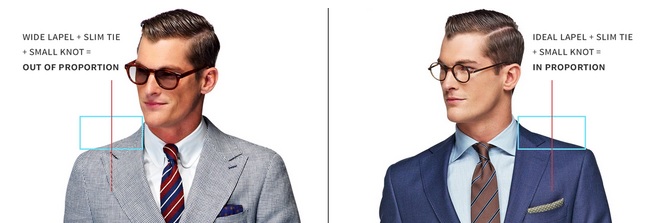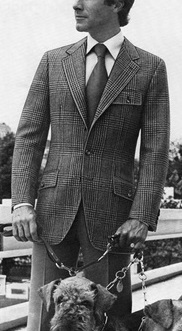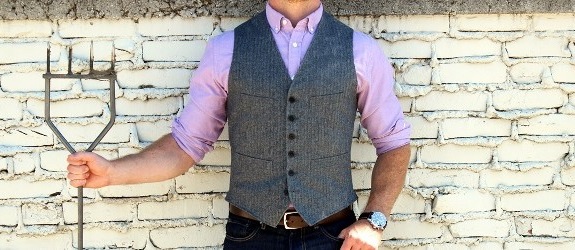Editor’s Note: This in-depth guest post is from reader Cesar Devers, and it explores which trends of the moment can actually be timeless looks for some. Leave your thoughts in the comments.
The Dappered masthead contains the phrase “Fashion is temporary and expensive. Style is timeless and affordable.” This oft-repeated distinction between fashion and style encapsulates what many consider to be a key distinction between men’s and women’s clothing: longevity. Menswear moves at a glacial pace compared to fashions of the fairer sex. You need only look at the various period shows on TV to see this. With some discrepancies, Frank Underwood, Don Draper, and Nucky Thompson dress essentially the same. Since the pace of Men’s style is so slow, we as men tend to avoid trends, since we don’t want to risk purchasing clothing that might look even slightly dated in a few years. Yet at the same time, we should also avoid the other side of the coin: categorically dismissing styles because they are trendy. In fact, certain trendy styles can be timeless and you should strongly consider embracing them.
Let’s look at some of the more popular trends in menswear and see who should be embracing these styles as part of their timeless wardrobe. Fair warning: the following argues in favor of trends, against trends, against “rules,” and in favor of pleats. Hopefully this piece encourages a few of you to try out a new style and really consider what flatters YOU, regardless of trends and rules.
Thinner Jacket Lapel Widths
Who it looks best on: Slimmer guys/those without broad chests.
You can’t read a thread about the J. Crew Ludlow without someone commenting on how skinny the lapels are. Some claim this will look dated soon (every year someone predicts that this will be the year lapels get wide and we all revert to some 1970’s Bee Gees fantasy). Even Joestradamus predicted the widening of the lapel for 2014. If so many people think the Ludlow lapel is too thin, then why is the Ludlow so popular? I think it’s because it flatters the thinner man who was, until very recently, completely ignored by mainstream suit makers. According to Alan Flusser, the guru of timeless style, lapel width “…should extend to just a fraction less than the halfway mark between the collar and shoulder line.” If you are a very thin gent, you would have a narrower jacket and therefore, to keep everything in proportion, a narrower lapel. So yes, for a man with a small frame, those “trendy” narrow lapels can look just as good in 10 years as they do now.
Slimmer Tie Widths
Who it looks best on: Guys who favor narrow lapels.
Thin is in. This has been the case for what feels like forever. Grumpy menswear “purists” think that tie width should hover around 3 ¼”. If you’re a man with a small frame and therefore wear a jacket with a narrower lapel, you should buy a narrower tie to maintain a balance. Come to think of it, there are some good thoughts about tie/jacket proportion on this post from 2011 by commenter Tom Kin Ta.

Same Suitsupply model, two different suits. The box and red line show the ‘ideal’ lapel width according to Flusser. On the left we have a discordant combination of a wider lapel with a thin tie. On the right, the lapel hits the ideal location. Also, because the gent has a small frame, the slim tie and Four in Hand knot pair nicely. Anyone else think the spread collar shirt with a Four in Hand looks odd? On left: Soho Light Blue Houndstooth ($599) On Right: Napoli Blue Plain ($399)
Little to No Pant Break
Who it looks best on: Guys with shorter legs compared to their torso.
We should be forever grateful to Thom Browne for channeling his love of suits into helping bring back slimmer-fitting menswear. Still, for all the good he’s done, he also made his signature no-break pants a trend that has been hard to shake. While you’d never call Browne’s style “timeless,” pant break is a great opportunity to visually lengthen or shorten your legs. The less break you have, the longer your legs will appear. If, for example, you have long legs compared to your torso, I’d suggest sticking with a more classic break. Check out this great guide from Effortless Gent for more on pant break. Really think hard about the break in your pants, because this is one of the more common alterations that men have to make. Many suits don’t come with hemmed pants so you’ll be getting your pants hemmed often. Don’t let a salesperson or tailor talk you into a break you won’t like. If you’re unsure, get more break. You can always have the pants taken up more later. Too little is irreversible.
Wearing a suit without a belt
Who it looks best on: Those with unusually long, or unusually short torsos.
The casual suit trend has brought with it a beltless trend. When the pendulum swings back, however, don’t be so quick to grab the belt. I firmly believe some men should never wear belts with suits. Belts divide your body at the hips (or waist, depending on where you wear your pants). Therefore, it visually draws attention to the ratio between your leg length and your torso length. If your torso and legs are about the same length, wear a belt with pride all the time. Have a short torso and long legs or vice versa? Consider going beltless when you wear a suit. It will provide a clean line from your upper to lower body and, when combined with a flattering jacket, give you better vertical proportions. However, going beltless means buying a suit that has no belt loops and instead uses side tabs or has buttons for suspenders (also known as braces, for our friends across the pond). You can have a tailor remove the belt loops from your trousers and add suspender buttons for a small fee.

Belts can divide. Beltless? Worth a shot.
Shorter Jacket Lengths
Who it looks best on: Guys with unusually long torsos.
Particularly short jacket length is the biggest trend right now in #menswear. Nothing says “I spend a lot of time on Tumblr” like a jacket that shows your entire rear-end while standing. Jackets should cover your entire rear, right? You should follow the finger curl test, right? Wrong. Well, sometimes wrong. Again, this all depends on the ratio between your leg length and your torso length. If you have a long torso, a jacket that covers your bottom will only serve to shorten your already relatively stumpy legs (editor’s note: Watch who you’re calling stumpy!). The opposite is true for men with relatively long legs and a short torso. A short jacket on that body type can leave the wearer looking oddly disproportional.

No pleats / Flat Front Pants
Who it looks best on: Those who don’t have big legs and/or a big rear.
Almost all the pants that the trendy menswear set have worn for the past 10 years or so have been flat-front. Chances are the dress pants you had when you were a kid had pleats. Taking these two data points, it would be easy to equate flat-front with modernity. However, doing so would ignore the cyclical nature of every aspect of fashion. The 1960’s was another period when flat-front was in. Nothing is inherently modern about not having pleats; flat-front is simply en vogue right now. The worst part about this trend, especially when combined with the slim trouser leg trend, is that you see many men squeezing themselves into pants that look ridiculously too tight. If you have big legs and/or a big rear, try pants with pleats. It might be hard to find well-cut pleated pants, but they exist.
Button Stance
 Higher stance looks best on: Those with longer torsos
Higher stance looks best on: Those with longer torsos
Lower stance looks best on: Those with short torsos
Button stance refers to the vertical placement of a three-button jacket’s middle button or a two-button jacket’s top button. Aside from J. Crew’s ludlow jackets, the current trend is towards a relatively high button stance. In Dressing the Man, Flusser states that the ideal button placement should “…divide the body so that the torso and legs appear at maximum length.” Notice Flusser doesn’t say something like “an inch below the belly button” or other commonly espoused “rules” of style. It is all about doing what is best for your body. If you have a short torso, try a lower button stance. It emphasizes the V-shape of your upper body and creates a more athletic look. Men with long torsos can go for a higher button stance and still look proportional.
Take a moment to admire the button stance on the man to the right. What was the trend when this picture was taken? Where is the button in relation to his belly button? No one cares because he nails it. (Image is from Rundschau magazine, 1978. Image was scanned by Sator and can be found here)
Pocket Squares
Who it looks best on: Those who don’t need to make their torsos look longer.
Pocket squares function similarly to belts in that they divide your upper body in half. Obviously, because pocket squares don’t go across your entire chest, the visual division isn’t as severe as a belt. Nevertheless, if you want to make your torso appear as long as possible, skip the pocket square.

Another visual divider. Like a belt for your chest. Kinda.
Vests/Waistcoats
Who it looks best on: Those with shorter torsos. Also, 19th century bartenders.
Maybe this trend has died down a bit, but we have all seen the casual vest with a knit tie and plaid shirt look that stores like J. Crew really push. Many “purists” say you should never wear a vest without a jacket. After all, most vests don’t have matching material that wraps around the back (usually it’s a satin like material so it moves well beneath the jacket you’re “supposed” to be wearing with it). But vests are a great way to visually lengthen your torso. Vests (also called waistcoats) should cover your waist. For that to happen, they extend past your beltline in the front. By both being a tad longer than your torso and obscuring the point where your shirt meets your pants, vests can make a man with a short torso and long legs look more in proportion vertically.

Waistcoats. Not for everyone, but they work on some.
Remember, it’s just as easy to get sucked into thinking in terms of “rules” as it is to become enamored with certain styles only because they are trendy. The great thing about trends is that they allow you to see a certain style across a wide variety of body shapes. Once a style becomes popular, all of the other men wearing it can act as examples of why a certain style would or wouldn’t flatter your body, and may even inspire you to attempt something you might have never thought of trying. One of the biggest examples of this is when Thom Browne and Don Draper colluded to trim the entire silhouette of menswear. Sure, Thom Browne took it to the extreme, but it was the first time many young men realized that men’s bodies have shape and that their shape should be flattered. Now most of us demand a flattering cut on our jackets, especially if we have something to show off; we have a trend to thank for that.
If you can learn from trends and make flattering style choices, you’ll achieve something very rare: timeless personal style. Once you have that, no one will think “oh my gawd, his pants have pleats,” but rather “damn, he looks good.”
Cesar Devers is a web developer and designer living in New York, NY. He once blew all of his summer internship money on great clothes with poor fit (for him) from the Brooks Brothers semi-annual clearance. Having to donate such wonderful clothes led him to become interested in menswear and the principles of proper fit.
